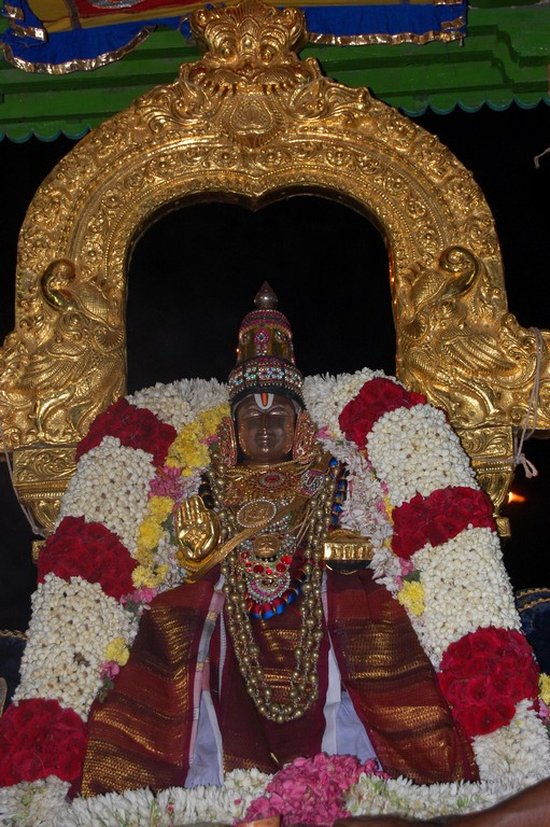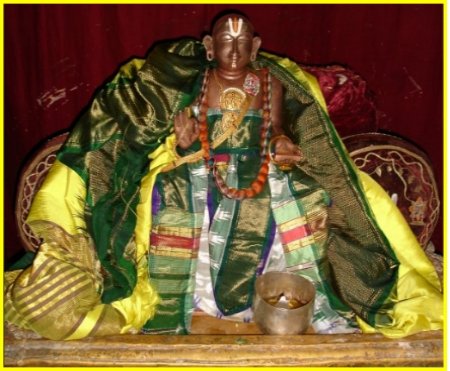Apart from being a master logician and a peerless philosopher, what distinguishes Swami Desikan from others of his genre is his undisputed mastery over poetry. He was a Taarkika Simham, Vedantancharya and Kavi Simham, all rolled into one. As it is, advanced philosophical or logical tenets are difficult to express in prose-to render them into verse with lilting metres and without sacrificing the sobriety of the matter, requires special accomplishment, which came naturally to Swami Desikan. Especially, his descriptions of Emperuman at various divyadesams are indeed impressive. Be it the head-to-foot depiction of Sri Rangaraja’s matchless splendour in “Bhagavat Dhyaana Sopaanam” or the mouth-watering descriptions of His soundaryam and laavanyam in “Sri Devanayaka Panchaasat”, “Sri Achyuta Satakam” etc., Swami Desikan is a past master in bringing Emperuman’s inimitable beauty before our eyes, making us thirst for the enchanting experience.
Normally, it takes a beautiful person, beautiful of physique or of intellect, to perceive and appreciate beauty in others. Going by this standard, we wonder what Swami Desikan himself looked like. The names of certain Acharyas conjure up before our minds’ eyes certain types of figures, as we have not had the fortune of seeing them in person.
When we think of Sri Ramanuja, for instance, we picturise him as a tall and impressive person with an ascetic appearance, with arms reaching down to his knees, face awash with the brilliance of deep devotion, the Yagyopaveetam sprawling across his broad chest, his broad forehead and other parts of the body adorned with oordhvapundram, his palms folded in typical devotion, clothed in ochre robes signifying his sanyaasa aashramam, deep-set eyes shining with the brilliance of blemishless wisdom and radiating boundless compassion, with the Tridandam held aloft and resembling a flagstaff of his comprehensive victory over opposing pseudo-Vedantic philosophers. This is how we normally picturise the Emperor of Yatis. And when we think of Sri Koorattazhwan, we think of him with a beard, for that is how most of his vigrahams appear. As far as the rest of the Acharyas are concerned, it appears to have been left pretty much to the sculptor’s imagination as to how they must have looked.
We know Swami Desikan intimately from his numerous and instructive works. Our respect, regard and love for him multiply themselves manifold, with every perusal of his masterly, yet compassionate and comprehensible Sreesooktis. However, the icons of Swami Desikan that we worship at various divyadesams do not present a uniform picture, though they are the same as far as the basics are concerned. For instance, the moorthy that we witness at Tiruvahindrapuram is quite different from the one to be seen at Tooppul, or for that matter, at Tirunarayanapuram or Tirukkudandai. All this makes us yearn for authentic information about how Swami Desikan had looked, when he inhabited this planet.
Fortunately, we do have a reliable account of Tooppul Pillai’s looks. As for being authentic, it couldn’t be more so, coming as it does from his illustrious son, Sri Kumara Varadacharya. Foreseeing the need of future generations of Srivaishnavas who, in the absence of Swami Desikan’s physical presence, would long to know how Swami looked in his vibhava dasa, Kumara Varadacharya has set it down in a Stotram of 15 slokas, aptly titled “Srimad Vedanta Desika Vigraha Dhyaanam”. Here are a few captivating glimpses from the Stotram.

We learn that Swami Desikan was extremely fair in complexion (as in conduct)-so much so that he resembled a shining Sun. In a slight variant, in Pillai Andaadi, the Acharya is said to possess a golden hue-“Sempon meni maaraada Tooppul Maal”. His overall appearance was one that would instantly capture our hearts and make us bow our heads in obeisance, says Sri Nynaracharya.
Embarking on a foot-to-head (“paadaadi kesam”) description of his father’s delectable persona, Kumara Varadacharya tells us next that Swami Desikan’s tiruvadis were a veritable pair of lotuses in full bloom. This is reiterated in Pillai Andaadi-“Tooppul vallal men malar adi”. The nails on his feet were pleasingly bright, like the soothing beams of the full moon, banishing the gloom of ignorance from the hearts of those who knelt at his holy feet. The soles of the feet were imprinted with signs of the lotus, Chakram and Shankham, similar to the Lord’s. His ankles were strong, akin to Cupid’s quiver, supporting shapely knees resembling the beautiful face of oxen and thighs similar to the tubular innards of the plantain tree (“Vaazhai Thandu”). The slender waist was covered by a pure white Vastram. Swami’s navel was deep.
Swami Desikan’s forehead resembled the Ashtami Chandran, shapely, broad and beautiful. This forehead was never empty, always adorned with bright Tiruman Kaappu. His hair was straight, white and long (obviously what we have here is an account of Swami Desikan in his advanced years). There was in Swami Desikan a marked resemblance to Sri Nammazhwar. This is hardly surprising, for, Swami Desikan had spent an entire lifetime in the study, analysis, preservation and propagation of Satakopa Muni’s sreesooktis, with several works such as Nigama Parimalam (unfortunately lost to us), Dramidopanishad Taatparya Ratnaavali, Dramidopanishad Saaram and Paduka Sahasram, all portraying the glory of Sri Nammazhwar. We tend to acquire the traits of the person who is constantly in our thoughts, adopting him as our role model. It is only a natural corollary of this maxim, that in looks too Swami Desikan grew to be like the divine bard he most admired.
Swami Desikan’s saintly face was bright and pleasant as the moon, but without any blemish. And the Acharya had a flowing white beard, which accentuated his scholarly and saintly appearance. This account lends credence to the view of scholars that Swami Desikan too, like Sri Koorattazhwan, grew a beard in his later years. The beard was long enough to touch his chest, flowing down like moon beams, from just below his lower lip. The cheeks were neither chubby nor shrunken, but with the right amount of flesh, and glass-like in their beauty. His broad chest was adorned by a pure white Yagyopaveetam, while his beautiful neck, resembling a shining white conch, was adorned with garlands made of lotus beads. His shoulders were high and rounded, with the collar bones appropriately hidden by fleshy cover. They were also adorned with glowing Shankham and Chakram, acquired during Samaashrayanam. His hands were long and sturdy, reaching down to his knees-a real “Ajaanubaahu”. His ears were shapely and fine-looking. The fingers adorning the hands were soft, supple, long and graceful. His face was always adorned by a beatific smile (“thoomuruval konda mukham”), compassionate, friendly and inviting. His beautiful lips resembled the just-sprouted tender leaves of a mango tree, always moist and fresh.
Swami Desikan’s teeth were straight, white and bright. Despite his advanced years at which this stotram appears to have been composed, the Acharya appears to have had a full set of pearly-white teeth, obviously due to the saatvic food he had been imbibing all his life. A slightly upturned and proportionate nose, resembling the sesame bloom, with flared nostrils, adorned the centre of his face. The nose resembled a slender creeper, from which appeared to blossom beautiful twin lotuses, representing the Swami’s compassionate and captivating eyes. The wide, beautiful eyes radiated compassion and understanding. Enchanting eyebrows formed fitting overhangs for these lotus-like eyes.
The entire tirmeni of the aged Acharya thus presented a picture of rare beauty, asceticism, grace, enchanting elegance and captivating charm, all of which are to be conjured up in our mind’s eye, when we recite the concluding lines of Pillai Andaadi-“Vadivazhagu aarnda van Tooppul Vallal”.
Kumara Varadacharya summarises all that has been said above about the captivating looks of Swami Desikan, in a single slokam, with a paadaadi kesa varnanam (reproduced below), to enable convenience of meditation-
“Sujaata charanaambujam, sudrida gulpha jaanu oorukam
sitaantara kati thatam subhaga naabhi vakshogalam
sudeergha yuga baahukam shubha kapola naasaakshikam
mano ruchira maalikam kalaya Venkatesam gurum”
When we worship Swami Desikan at Tooppul, his holy face appears to confirm that whatever Kumara Varadacharya has portrayed is no exaggeration, but a mere statement of fact.
Srimate Sri Lakshminrisimha divya paduka sevaka SrivanSatakopa Sri Narayana
Yatindra Mahadesikaya nama:
dasan, sadagopan









